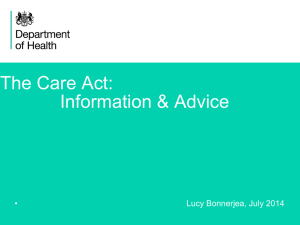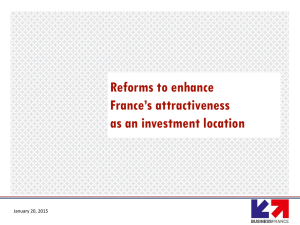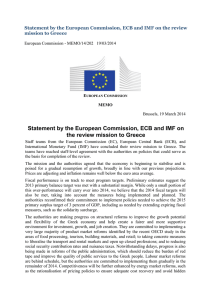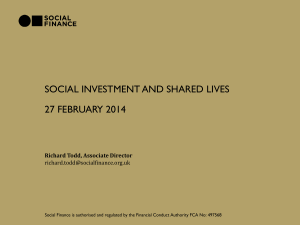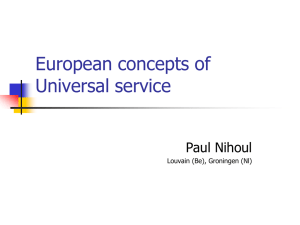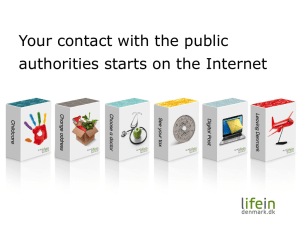Please click here to the PowerPoint presentation
advertisement
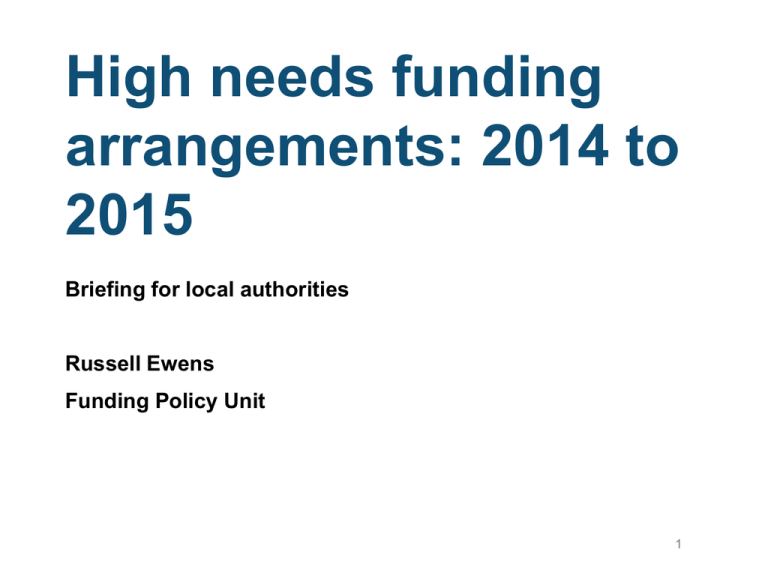
High needs funding arrangements: 2014 to 2015 Briefing for local authorities Russell Ewens Funding Policy Unit 1 High needs: priorities for local authorities • Knowing about the high needs changes in 2014 to 2015 • Understanding the place review exercise • Using the high needs templates 2 Context for 2014 to 2015 changes • High needs funding one element of wider funding reforms • School funding reforms – the £6k threshold • Data collection process for distribution of place funding led by local authorities 3 SEN reforms in Children and Families Bill • New Education, Health and Care Plans • Joint commissioning and delivery across education, health and social care services • Local authorities publishing their local offer of services to support SEND • New statutory duties due to come into effect from September 2014 4 2014 to 2015 place funding • Place funding about a third of high needs funding outside school budgets • Accurate place funding gives security to institutions, and gives LAs greater control over top-up funding • Intention to base place funding for 2015 to 2016 onwards on prior year data • For 2014 to 2015, therefore, expect place numbers to be closely based on the actual numbers of placements commissioned in institutions for current year 2013 to 2014 5 Places review timeline Date Event July 2013 Initial information published Local authorities received data September/ October 2013 Briefings to local authorities on high needs arrangements October 2013 High needs templates issued to authorities November 2013 High needs template re-issued to include 2012 to 2013 actual post 16 data Before 23 December 2013 Local authorities return templates to EFA January 2014 onwards EFA calculate allocations to authorities and institutions 6 Role of local authorities Local Authority Prime responsibility for planning and funding high needs Work with schools, academies and schools forum Work with institutions and other local authorities to review distribution of places Embed other aspects of high needs funding and SEN reforms Review and confirm individual pupil/student placements and associated top-up funding 7 Education Funding Agency Role of the Education Funding Agency Support local authorities on high needs funding issues Support local authorities’ place review activity Consider authorities’ submissions and institutions’ exceptional cases Provide final DSG allocations to local authorities and other funding allocations to institutions 8 Institutions Role of institutions Get involved in places review activity with local authorities commissioning places and, for maintained schools and academies, with their ‘home’ authority (if different) Accurately complete the school census and the individualised learner record (ILR) in October NB institutions do not need to return any other data 9 High needs budget issues • Total national high needs budget for the financial year 2014 to 2015 yet to be decided • Working on the expectation that resources will continue to be tight and increases in some allocations will need to be balanced by reductions in others • Increases in places – how they will be funded • Increases in top-up funding and central services costs 10 High needs template • Simpler approach. Greater alignment across pre- and post16 data • Important to understand the differences in place data requested • Templates emailed to local authorities on 4 October with a user guide I agree that the place numbers I have submitted are our best available assessment on 23 December - Please click to complete the Declaration. LA Name: LA Number: Completed by: Email address: Phone number: Test LA 999 Mr X testLA@education.com 070000000 Cell colour guide User input cells Prepopulated cells Calculation cells Recommended use of the HNT: Please ensure that automatic calculation and macros are enabled 1. Review the list of institutions prepopulated in the 2014 to 2015 high needs places sheet. 2. Use the New Institutions & Adjustments sheet to record any changes. 3. Return to the 2014 to 2015 high needs places sheet and, where necessary, amend the 2014 to 2015 high needs places as appropriate. 4. Ensure you are content with the summary of your proposed 2014 to 2015 high needs places in the table below and click the button at the top of this sheet. This will take you to a declaration sheet, which has to be completed before submission. Email Address for any queries is: HighNeeds.SOUTHERN@education.gsi.gov.uk Pre 16 Post 16 2014 to 2015 2014 to 2015 total Total Baseline 2014 to 2015 SEN 2014 to 2015 AP high needs places total high needs places places return places return places return return 274 159 65 50 274 Difference between 2014 to 2015 and 2013 to 2014 total high needs places 0 If you wish to make a collaborative submission please select the LAs you will be collaborating with from the drop-down list below, listing the lead LA who will be responsible for returning the collaborative submission first. Otherwise please leave blank • Templates re-issued at the end of November. Local authorities return this version before 23 December Lead LA 11 More information • High Needs for Local Authority Webinar – Monday 4th November, register via the Live Portal: https://registration.livegroup.co.uk/academyfunding/ • 2014 to 2015 Revenue Funding Arrangements, available from .gov.uk: https://www.gov.uk/government/publications/2014-to-2015-revenue-fundingarrangements-operational-information-for-local-authorities • Implementing high needs place funding arrangements for 5-25 year olds 2014 to 2015, available on the DfE website: http://media.education.gov.uk/assets/files/pdf/h/high%20needs%202014%20to %202015%2018%20july%20final.pdf • An October update on high needs funding arrangements in academic year 2014 to 2015, available from .gov.uk https://www.gov.uk/government/publications/high-needs-fundingarrangements-in-academic-year-2014-to-2015 12



